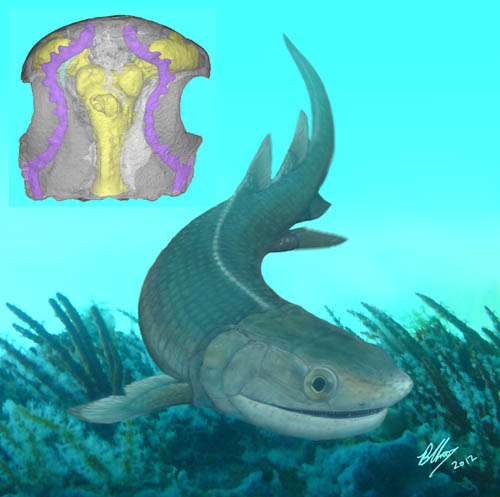| Location: Home > Research > Research Progress |
| Earliest Known Finned Tetrapod Found From the Lower Devonian of China |
|
An international team led by Dr. ZHU Min, Institute of Vertebrate Paleontology and Paleoanthropology (IVPP), Chinese Academy of Sciences, described a new finned primitive tetrapod, Tungsenia paradoxa gen. et sp. nov., from the Lower Devonian (Pragian, about 409 million years ago) of Yunnan, China, which extends the earliest record of tetrapods by some 10 million years and unveils the medial aspect of mandible and unrecognised aspects of the neurocranial anatomy. Researchers reported online Oct. 23 in Nature Communications.
Living tetrapods, such as frogs, turtles, birds and mammals, are a subgroup of the tetrapod lineage (tetrapod total group or tetrapodomorphs). The lineage also includes finned and limbed tetrapods that are more closely related to living tetrapods than to living lungfishes. Previously, the undisputed earliest known primitive tetrapod was Kenichthys, a finned member from the late Emsian (about 399 million years ago) of Yunnan, China. However, a paucity of fossil data from primitive finned tetrapods prevents profound understanding of the acquisition sequence of tetrapod characters. The new material was collected from a yellow sandstone layer of the Posongchong Formation, near the dam of the Qingmen Reservoir in the suburb of Zhaotong, northeastern Yunnan, South China. “The parietal shield and two lower jaws were originally described as an indeterminate osteolepid as these specimens were not fully prepared. After the discovery of complementary specimens from the same locality, we further prepared the original material and ultimately observed the medial aspect of mandible and the neurocranial anatomical featuers”, said first author LU Jing of the IVPP. Tungsenia displays a mixture of endocranial features previously found either in basal lungfishes (for example, paired internasal pits, broad parasphenoid and exits for trigeminal and profundus nerves in the parietal shield) or in tetrapodomorphs (for example, the position of the pituitary vein opening). It further fills in the morphological gap between tetrapods and lungfishes, and unveils the evolutionary pattern of character changes during the initial diversification of primitive tetrapods. Different from the mosaic cranial features, the mandible of Tungsenia displays undisputed primitive tetrapod features, suggesting that, at the early stage of the tetrapod evolution, changes in mandible were faster than changes in endocranium. "The basal phylogenetic position, unique character combination and earlier occurrence of Tungsenia have wide implications for the study of the tetrapod ancestry. The new taxon has extended the fossil record of tetrapods by some 10 million years”, said coauthor John A. Long, Natural History Museum of Los Angeles County, California, “Thus, the first appearance of the tetrapod total group has now been drawn far closer to the estimated time of the lungfish–tetrapod split.” "Tungsenia provides unique insights into the incipient stage of tetrapod brain evolution. The X-ray tomography study of the skull depicts the ancestral (plesiomorphic) condition of the brain in the tetrapods”, said corresponding author ZHU Min of the IVPP, “The enlargement of the cerebral hemispheres and the possible presence of the pars tuberalis in this primitive finned tetrapod indicate that some important brain modifications related to terrestrial life had occurred at the beginning of the tetrapod evolution, much earlier than previously thought.” This work was supported by the Major State Basic Research Projects of MST of China, the National Natural Science Foundation of China, the Chinese Academy of Sciences, State Key Laboratory of Palaeobiology and Straigraphy, and the ARC Discovery grant.  Fig.1 Photo of endocasts of Tungsenia paradoxa, and digital restorations of endocasts and endocranial cavity. (Image by LU Jing)
 Fig.2 Life restoration of Tungsenia paradoxa. (Image by B. Choo) |